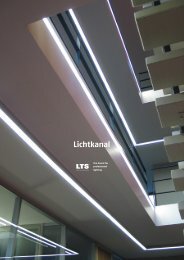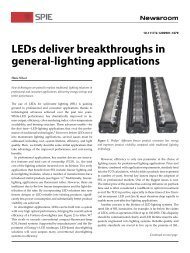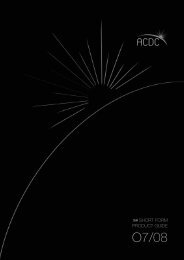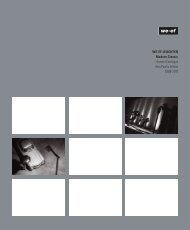Energy efficiency in lighting â considerations and possibilities
Energy efficiency in lighting â considerations and possibilities
Energy efficiency in lighting â considerations and possibilities
Create successful ePaper yourself
Turn your PDF publications into a flip-book with our unique Google optimized e-Paper software.
Light<strong>in</strong>g Res. Technol. 2009; 41: 209–218<br />
<strong>Energy</strong> <strong>efficiency</strong> <strong>in</strong> light<strong>in</strong>g – <strong>considerations</strong><br />
<strong>and</strong> <strong>possibilities</strong><br />
DL Loe MPhil CEng FSLL, FIESNA, FCIBSE<br />
48, New Park Drive, Hemel Hempstead, Hertfordshire, HP2 4QE, UK<br />
Received 6 November 2008; Revised 20 March 2009; Accepted 3 April 2009<br />
<strong>Energy</strong> <strong>efficiency</strong> is a prime consideration for all light<strong>in</strong>g professionals with<br />
reasons rang<strong>in</strong>g from the threat of climate change through burn<strong>in</strong>g fossil fuels to<br />
the susta<strong>in</strong>ability <strong>and</strong> availability of energy supplies as well as rapidly <strong>in</strong>creas<strong>in</strong>g<br />
costs. But it must be balanced aga<strong>in</strong>st the need for well-lit environments to ensure<br />
the productivity, well-be<strong>in</strong>g, safety <strong>and</strong> health of the people it serves. A well-lit<br />
environment must provide both visual function <strong>and</strong> visual amenity for the<br />
particular application <strong>and</strong> for the architecture, together with an efficient use of<br />
energy. This means consider<strong>in</strong>g all the elements that contribute to the design <strong>and</strong><br />
operation <strong>in</strong> an all-embrac<strong>in</strong>g manner. The challenge now is to address more<br />
critically the design, operation <strong>and</strong> specification of electric light<strong>in</strong>g <strong>in</strong> comb<strong>in</strong>ation<br />
with available daylight. This will require new th<strong>in</strong>k<strong>in</strong>g <strong>and</strong> research to achieve<br />
satisfactory, efficient environments that will need <strong>in</strong>vestment for optimum results.<br />
But the outcome could be a long-term benefit to society with the benefit be<strong>in</strong>g<br />
greater than the sum of the parts.<br />
1. Introduction<br />
There is no doubt that energy <strong>efficiency</strong> is<br />
now an essential consideration for all light<strong>in</strong>g<br />
professionals. This has been prompted, <strong>in</strong>itially,<br />
by the widely held view that burn<strong>in</strong>g<br />
fossil fuels causes carbon dioxide emissions,<br />
which <strong>in</strong> turn can contribute to climate<br />
changes that could have dramatic environmental<br />
implications affect<strong>in</strong>g the planet.<br />
More recently, however, there is the substantial<br />
<strong>in</strong>crease <strong>in</strong> energy costs particularly<br />
through the dramatic <strong>in</strong>crease <strong>in</strong> the cost of<br />
oil <strong>and</strong> gas. There is also the subject of<br />
susta<strong>in</strong>ability – it is estimated that around<br />
80% of the UK electricity is generated by<br />
burn<strong>in</strong>g fossil fuels, much of which comes<br />
from abroad. In the long term these are a<br />
f<strong>in</strong>ite resource, which will one day run out,<br />
Address for correspondence: DL Loe, 48, New Park Drive,<br />
Hemel Hempstead, Hertfordshire, HP2 4QE, UK.<br />
E-mail: davidloe20@bt<strong>in</strong>ternet.com<br />
but even <strong>in</strong> the short term it means that the<br />
UK depends on resources beyond its direct<br />
control, which is a situation that applies to<br />
other countries too. Because of all these<br />
elements, the light<strong>in</strong>g profession must take a<br />
responsible view of energy <strong>efficiency</strong> <strong>and</strong> do<br />
all it can to m<strong>in</strong>imise electricity consumption<br />
whilst, at the same time, ensur<strong>in</strong>g high-quality<br />
lit environments for the people it aims to<br />
serve.<br />
It is estimated that UK electric light<strong>in</strong>g<br />
currently consumes around 58,000 GWh per<br />
annum, this amounts to 20% of the total<br />
amount of electricity generated. It has also<br />
been estimated that of that 20%, the electricity<br />
consumed by light<strong>in</strong>g divides by application<br />
as follows: Service Light<strong>in</strong>g (retail,<br />
commercial, exterior etc.) 11.5%, Industrial<br />
2.6% <strong>and</strong> Domestic 5.9%. It must be stressed,<br />
however, that some of this <strong>in</strong>formation stems<br />
from studies made <strong>in</strong> the mid-1990s, conta<strong>in</strong>ed<br />
with<strong>in</strong> an <strong>in</strong>ternal Build<strong>in</strong>g Research<br />
Establishment report, so it may not be<br />
ß The Chartered Institution of Build<strong>in</strong>g Services Eng<strong>in</strong>eers 2009 10.1177/1477153509338884
210 DL Loe<br />
accurate for the present day, but it does serve<br />
to <strong>in</strong>dicate the size of the problem.<br />
However, although the amount of electricity<br />
consumed by light<strong>in</strong>g is an important<br />
issue, it must be balanced aga<strong>in</strong>st the<br />
functional <strong>and</strong> amenity requirements of the<br />
users. For to reduce the human effectiveness<br />
of the illum<strong>in</strong>ation, on the basis of energy<br />
<strong>efficiency</strong>, would be a serious retrograde step<br />
for human performance <strong>and</strong>, <strong>in</strong> the long term,<br />
counter-productive. Therefore, the problem<br />
that the light<strong>in</strong>g profession must address is<br />
how to provide illum<strong>in</strong>ation to at least<br />
modern day best practice st<strong>and</strong>ards while, at<br />
the same time, us<strong>in</strong>g the m<strong>in</strong>imum amount<br />
of electricity necessary. This will require<br />
considerable attention from the light<strong>in</strong>g<br />
<strong>in</strong>dustry <strong>and</strong> the design professions. It will<br />
also require them to be imag<strong>in</strong>ative <strong>and</strong><br />
<strong>in</strong>novative <strong>and</strong> to look beyond the solutions<br />
often provided today.<br />
New energy efficient solutions will<br />
also require clients to be prepared for<br />
higher <strong>in</strong>stallation costs <strong>and</strong> users to be<br />
prepared to be open m<strong>in</strong>ded to new light<strong>in</strong>g<br />
solutions <strong>in</strong>clud<strong>in</strong>g their operation. To<br />
achieve this will require the attention of the<br />
research <strong>and</strong> development community, particularly<br />
those deal<strong>in</strong>g with light<strong>in</strong>g equipment,<br />
light <strong>and</strong> light<strong>in</strong>g measurements <strong>and</strong><br />
light<strong>in</strong>g design.<br />
It will also require <strong>in</strong>vestigations by behavioural<br />
scientists who specialise <strong>in</strong> human<br />
factors relat<strong>in</strong>g to light <strong>and</strong> light<strong>in</strong>g. Light<strong>in</strong>g<br />
as we know it today, <strong>in</strong> many ways is still <strong>in</strong><br />
its <strong>in</strong>fancy, particularly relat<strong>in</strong>g to our knowledge<br />
on the effect of light <strong>and</strong> light<strong>in</strong>g on<br />
human response, <strong>and</strong> hence on performance<br />
<strong>in</strong> the widest sense. But with a greater<br />
underst<strong>and</strong><strong>in</strong>g of these issues, together with<br />
the need to be as energy efficient as possible<br />
<strong>in</strong> how light<strong>in</strong>g is provided, there arises an<br />
opportunity for the profession to move light<strong>in</strong>g<br />
from be<strong>in</strong>g purely a build<strong>in</strong>g service to a<br />
service that enhances human performance,<br />
well-be<strong>in</strong>g <strong>and</strong> health.<br />
2. Areas for consideration<br />
To beg<strong>in</strong> to see how improved energy <strong>efficiency</strong><br />
<strong>in</strong> light<strong>in</strong>g might be achieved it will be<br />
useful to explore the cha<strong>in</strong> between the<br />
electricity supply <strong>and</strong> the illum<strong>in</strong>ation<br />
required for the particular situation. But <strong>in</strong><br />
the end it is the number of units of electricity<br />
that are consumed, with respect to time, for a<br />
given light<strong>in</strong>g performance that will determ<strong>in</strong>e<br />
its energy <strong>efficiency</strong>.<br />
The amount of energy used is determ<strong>in</strong>ed<br />
by the light<strong>in</strong>g equipment e.g. the lamps <strong>and</strong><br />
lum<strong>in</strong>aires. It will also be determ<strong>in</strong>ed by the<br />
light<strong>in</strong>g requirement for the application,<br />
which <strong>in</strong>cludes both the task illum<strong>in</strong>ation<br />
<strong>and</strong> the light<strong>in</strong>g, which illum<strong>in</strong>ates the surround<strong>in</strong>gs,<br />
sometimes referred to as ambient<br />
or build<strong>in</strong>g light<strong>in</strong>g to complement the task<br />
illum<strong>in</strong>ation. This will determ<strong>in</strong>e the type <strong>and</strong><br />
number of lum<strong>in</strong>aires used. It will also be<br />
determ<strong>in</strong>ed by the degree of <strong>in</strong>stallation<br />
ma<strong>in</strong>tenance to ensure the light<strong>in</strong>g equipment<br />
is at optimum operation.<br />
The total number of units of electricity<br />
consumed by the light<strong>in</strong>g <strong>in</strong>stallation will also<br />
be affected by the length of time the light<strong>in</strong>g is<br />
switched on. This will be affected by the<br />
amount of daylight that is present <strong>and</strong><br />
whether the room is occupied, but also<br />
whether there are suitable light<strong>in</strong>g controls.<br />
These may be manual or automatic, or a<br />
comb<strong>in</strong>ation between the two to ensure optimum<br />
light<strong>in</strong>g conditions without light<strong>in</strong>g<br />
be<strong>in</strong>g left on unnecessarily, which is often<br />
the case. They must also be ‘user friendly’.<br />
To most light<strong>in</strong>g professionals this cha<strong>in</strong> of<br />
elements affect<strong>in</strong>g light<strong>in</strong>g electricity consumption<br />
will be obvious, as will the fact that<br />
all elements need to be considered for optimum<br />
energy <strong>efficiency</strong>. However, it is not<br />
always obvious to clients who may look at the<br />
<strong>in</strong>itial capital cost of an <strong>in</strong>stallation rather<br />
than consider<strong>in</strong>g the capital costs <strong>in</strong> conjunction<br />
with the occupant’s performance <strong>and</strong> the<br />
operat<strong>in</strong>g costs, all of which will be important.<br />
Light<strong>in</strong>g Res. Technol. 2009; 41: 209–218
<strong>Energy</strong> <strong>efficiency</strong> <strong>in</strong> light<strong>in</strong>g 211<br />
Nor is it apparently obvious to governments<br />
anxious to reduce energy dem<strong>and</strong> – see the<br />
hasty <strong>and</strong> ill-considered proposal to withdraw<br />
some <strong>in</strong>c<strong>and</strong>escent lamps from the market to<br />
encourage a greater use of compact fluorescent<br />
lamps (CFLs) – which has caused much<br />
disquiet by the public <strong>and</strong> the profession.<br />
3. Considerations for improved energy<br />
<strong>efficiency</strong><br />
The light<strong>in</strong>g <strong>in</strong>dustry has made considerable<br />
advances over recent years <strong>in</strong> improv<strong>in</strong>g<br />
light<strong>in</strong>g equipment both <strong>in</strong> terms of quality<br />
<strong>and</strong> <strong>efficiency</strong>, but areas rema<strong>in</strong> which still<br />
deserve consideration. Figure 1 <strong>in</strong>dicates the<br />
elements between the electricity consumed<br />
<strong>and</strong> the light<strong>in</strong>g <strong>in</strong>stallation where energy<br />
<strong>efficiency</strong> may need further consideration.<br />
3.1 Lamps <strong>and</strong> light measurement<br />
Over the last few decades lamps have<br />
developed considerably through improved<br />
efficacy (lumens/watt), colour performance<br />
<strong>and</strong> operation, but one problem that has<br />
emerged, particularly through the pressure on<br />
consumers to switch to us<strong>in</strong>g more CFLs,<br />
particularly those with <strong>in</strong>tegrated control<br />
gear, is that the same light output, or lumen<br />
output, from a GLS <strong>in</strong>c<strong>and</strong>escent lamp to<br />
that emitted by a CFL does not appear to be<br />
equal. The manufacturers’ claim an energy<br />
<strong>efficiency</strong> ratio between <strong>in</strong>c<strong>and</strong>escent lamps<br />
<strong>and</strong> CFLs is typically 5 : 1 (or sometimes even<br />
6 : 1). In other words an <strong>in</strong>c<strong>and</strong>escent lamp<br />
provides 12 lumens per watt while a CFL<br />
provides 60 lumens per watt. This suggests a<br />
considerable sav<strong>in</strong>g of electricity as well as an<br />
<strong>in</strong>creased lamp life. However the perceived<br />
ratio is nearer to 3 : 1. In non-critical situations<br />
this may not matter but <strong>in</strong> many cases it<br />
does. Also when a CFL has a similar colour<br />
appearance <strong>and</strong> colour render<strong>in</strong>g numerical<br />
rat<strong>in</strong>g to an <strong>in</strong>c<strong>and</strong>escent lamp they often<br />
do not appear to be sufficiently the same,<br />
particularly for critical tasks. There are other<br />
problems too regard<strong>in</strong>g run-up times, UV<br />
emission, poor power factor correction <strong>and</strong><br />
mercury content. This has led to dissatisfaction<br />
by consumers <strong>and</strong> has damaged the move<br />
to improved energy <strong>efficiency</strong>.<br />
The reason for this is probably because the<br />
spectral distributions of the two lamp types are<br />
very different <strong>in</strong> that the <strong>in</strong>c<strong>and</strong>escent lamp<br />
has smooth distribution, similar to a black<br />
body, while a CFL has a distribution with<br />
many peaks <strong>and</strong> troughs. An <strong>in</strong>terest<strong>in</strong>g addition<br />
to this problem is that modern l<strong>in</strong>ear<br />
fluorescent lamps do not appear to suffer the<br />
same difficulties. What this suggests is that our<br />
measurement systems, either of lum<strong>in</strong>ous flux<br />
<strong>in</strong> lumens, or colour performance <strong>in</strong>clud<strong>in</strong>g<br />
colour render<strong>in</strong>g <strong>and</strong> colour appearance, are<br />
not sufficiently critical to meet the needs of the<br />
user <strong>and</strong> a more critical approach is necessary.<br />
This is a disturb<strong>in</strong>g issue because lum<strong>in</strong>ous<br />
flux <strong>and</strong> light colour measurements are central<br />
to illum<strong>in</strong>ation provision <strong>and</strong> development.<br />
It is essential therefore that work needs to be<br />
done to <strong>in</strong>vestigate these differences <strong>and</strong> where<br />
necessary to make changes. A further related<br />
problem is <strong>in</strong> measur<strong>in</strong>g the light<strong>in</strong>g <strong>and</strong><br />
colour performance of light emitt<strong>in</strong>g diodes<br />
(LEDs). If changes to our measurement<br />
systems are required they will have major<br />
implications, but it is important that the<br />
subject is given some priority rather than<br />
be<strong>in</strong>g ignored with the hope it will go away.<br />
Figure 2 <strong>in</strong>dicates where light <strong>and</strong> light<strong>in</strong>g<br />
measurements need to be considered for<br />
modern times with the aim of improved<br />
energy <strong>efficiency</strong> <strong>and</strong> human performance.<br />
3.2 Light<strong>in</strong>g design<br />
From the very beg<strong>in</strong>n<strong>in</strong>g of electric light<strong>in</strong>g<br />
provision the people <strong>in</strong>volved recognised that<br />
light<strong>in</strong>g was a comb<strong>in</strong>ation of art <strong>and</strong> science,<br />
or more correctly function <strong>and</strong> appearance.<br />
They also recognised that fundamental to it<br />
was the human reaction to light <strong>and</strong> light<strong>in</strong>g<br />
<strong>in</strong> terms of visual ability <strong>in</strong>clud<strong>in</strong>g comfort <strong>and</strong><br />
Light<strong>in</strong>g Res. Technol. 2009; 41: 209–218
212 DL Loe<br />
Approx. 20%<br />
UK electricity<br />
is used for<br />
light<strong>in</strong>g<br />
Efficacy<br />
Flicker<br />
Light<br />
production<br />
Colour<br />
performance<br />
Health<br />
Intensity<br />
distribution<br />
Lum<strong>in</strong>aire<br />
optics<br />
Optical<br />
<strong>efficiency</strong><br />
On/off<br />
<strong>and</strong> dim<br />
Light<strong>in</strong>g<br />
controls<br />
Manual<br />
<strong>and</strong> automatic<br />
Light<strong>in</strong>g design<br />
Function (<strong>in</strong>terior <strong>and</strong><br />
exterior)<br />
Amenity<br />
Daylight<br />
Figure 1 Elements <strong>in</strong> the provision of light <strong>and</strong> light<strong>in</strong>g that need to be considered for enhanced human performance<br />
<strong>and</strong> energy <strong>efficiency</strong><br />
<strong>efficiency</strong>, but they also believed that it <strong>in</strong>fluenced<br />
the psychological profile of human<br />
be<strong>in</strong>gs, which <strong>in</strong> turn would affect performance.<br />
Health is another issue that needs to be<br />
addressed <strong>and</strong> over the years it has been<br />
claimed that light exposure is essential to<br />
good health, <strong>and</strong> yet people work<strong>in</strong>g most of<br />
their lives <strong>in</strong>doors now have a much less<br />
exposure than their forefathers. Also there<br />
have been claims of light hav<strong>in</strong>g detrimental<br />
effects <strong>in</strong>clud<strong>in</strong>g the possibility of caus<strong>in</strong>g<br />
cancer. The subject of human reaction to light<br />
<strong>and</strong> light<strong>in</strong>g desperately needs further <strong>in</strong>vestigation<br />
to improve human <strong>and</strong> energy <strong>efficiency</strong>.<br />
Light<strong>in</strong>g Res. Technol. 2009; 41: 209–218
<strong>Energy</strong> <strong>efficiency</strong> <strong>in</strong> light<strong>in</strong>g 213<br />
Light<strong>in</strong>g<br />
appearance<br />
Brightness <strong>and</strong><br />
lightness<br />
Lum<strong>in</strong>ous<br />
flux<br />
Light colour<br />
performance<br />
Light <strong>and</strong> light<strong>in</strong>g<br />
metrology<br />
Illum<strong>in</strong>ance<br />
level <strong>and</strong> distribution<br />
Lum<strong>in</strong>ance<br />
level <strong>and</strong> distribution<br />
Task<br />
illum<strong>in</strong>ation<br />
Light<strong>in</strong>g<br />
electricity<br />
consumed<br />
Light<strong>in</strong>g<br />
appearance<br />
Figure 2 Elements of light <strong>and</strong> light<strong>in</strong>g metrology that need to be considered for enhanced visual effectiveness <strong>and</strong><br />
energy <strong>efficiency</strong><br />
Many good quality modern light<strong>in</strong>g <strong>in</strong>stallations,<br />
particularly <strong>in</strong> offices <strong>and</strong> other places<br />
of work, comprise a regular array of ceil<strong>in</strong>g<br />
mounted lum<strong>in</strong>aires, the lum<strong>in</strong>aires hav<strong>in</strong>g a<br />
lum<strong>in</strong>ous <strong>in</strong>tensity distribution that avoids<br />
direct discomfort glare <strong>and</strong> glare reflected<br />
from display screens, as well as noticeable<br />
flicker. These <strong>in</strong>stallations are designed to<br />
provide a near uniform horizontal work<strong>in</strong>g<br />
plane illum<strong>in</strong>ance of a value appropriate for<br />
the application. This means that the occupants<br />
should have optimum work<strong>in</strong>g conditions<br />
<strong>and</strong> if high-quality light<strong>in</strong>g equipment is<br />
selected, <strong>in</strong>stalled <strong>and</strong> ma<strong>in</strong>ta<strong>in</strong>ed, should<br />
have good energy <strong>efficiency</strong> as well.<br />
However, because this approach provides a<br />
uniform light<strong>in</strong>g condition with little flexibility,<br />
energy can be wasted through illum<strong>in</strong>ation<br />
be<strong>in</strong>g provided to a level, or at a location,<br />
not required. Modern light<strong>in</strong>g controls can<br />
provide different conditions either on–off or<br />
dimmed, relative to occupancy or to the<br />
amount of daylight present, but often they<br />
do not meet user’s requirements, <strong>and</strong> hence<br />
do not provide the sav<strong>in</strong>g expected because of<br />
user dissatisfaction or sabotage. Another<br />
possible problem is that modern light<strong>in</strong>g<br />
equipment conta<strong>in</strong>s electronic components,<br />
that sometimes, do not have the life <strong>and</strong><br />
reliability of old fashioned wire <strong>and</strong> metal<br />
Light<strong>in</strong>g Res. Technol. 2009; 41: 209–218
214 DL Loe<br />
components, but this is a manufactur<strong>in</strong>g<br />
problem <strong>and</strong> by us<strong>in</strong>g quality equipment it<br />
can be overcome.<br />
For many years now some light<strong>in</strong>g<br />
designers <strong>and</strong> researchers have claimed that<br />
the lit appearance of a space affects the<br />
performance of the occupants. There have<br />
been examples when the correct horizontal<br />
task illum<strong>in</strong>ance has been provided, but the<br />
occupants were dissatisfied because the room<br />
appeared gloomy. Often the problem was<br />
caused by low reflectance wall f<strong>in</strong>ishes <strong>in</strong><br />
comb<strong>in</strong>ation with lum<strong>in</strong>aires which provided<br />
little light on vertical surfaces, <strong>and</strong> hence the<br />
room did not appear ‘light’ <strong>and</strong> was deemed<br />
to be under-lit <strong>and</strong> therefore unsatisfactory.<br />
In the 1960’s a number of studies were<br />
made to test subjectively the acceptability of a<br />
lit room <strong>in</strong> terms of ‘is there sufficient light<br />
for the task’ One study by Saunders 1 showed<br />
that when a room was lit by ceil<strong>in</strong>g mounted<br />
diffuser type fluorescent lamp lum<strong>in</strong>aires the<br />
observers preferred the condition where at<br />
least 1000 lx was provided on the work<strong>in</strong>g<br />
plane. Whereas visual performance tests<br />
would have <strong>in</strong>dicated that only 500 lx was<br />
necessary. This suggests that it is not just the<br />
task illum<strong>in</strong>ance that needs to be considered,<br />
but the illum<strong>in</strong>ation of the whole space.<br />
Other studies on light<strong>in</strong>g appearance by<br />
Loe et al. 2 have claimed that not only do<br />
observers prefer a space to appear ‘visually<br />
light’ they also like an element of ‘visual<br />
<strong>in</strong>terest’ – or a degree of light <strong>and</strong> shade. This<br />
provides the occupants with a more <strong>in</strong>terest<strong>in</strong>g<br />
<strong>and</strong> stimulat<strong>in</strong>g space, which <strong>in</strong> turn could<br />
enhance performance, but proof of this<br />
has been illusive. However recently, Veitch<br />
et al. 3 has suggested, that through a ‘l<strong>in</strong>ked<br />
mechanisms approach’ this may <strong>in</strong>deed be<br />
the case.<br />
A further consideration is that there are<br />
advantages to the occupants work<strong>in</strong>g conditions<br />
if the task is lit to a slightly higher<br />
level than the surround<strong>in</strong>gs <strong>and</strong> a ratio of 3 : 1<br />
is often suggested <strong>in</strong> light<strong>in</strong>g design codes.<br />
It is claimed that this approach focuses<br />
attention on the task <strong>and</strong> could improve<br />
performance, but it is not sufficient to provide<br />
a traditional desk light to create a high<br />
illum<strong>in</strong>ance patch of light just on the task.<br />
Nonetheless this approach would reduce the<br />
average horizontal plane illum<strong>in</strong>ance perhaps<br />
by as much as half, <strong>and</strong> hence the electricity<br />
consumption. 4<br />
A further element of a light<strong>in</strong>g <strong>in</strong>stallation<br />
that needs development is the way it is<br />
controlled. All too often light<strong>in</strong>g is left on<br />
unnecessarily, either because the electric light<br />
is superfluous to the daylight or because<br />
people are away <strong>and</strong> hence energy is wasted.<br />
There are many control systems both<br />
manual <strong>and</strong> automatic, but few operate as<br />
well as <strong>in</strong>tended because they are not sufficiently<br />
user-friendly. The problems <strong>in</strong>clude<br />
<strong>in</strong>dividuals not be<strong>in</strong>g responsible for their<br />
own light<strong>in</strong>g. Perhaps, because the light<strong>in</strong>g<br />
design is such, that particular lum<strong>in</strong>aires do<br />
not relate to an <strong>in</strong>dividual’s work area. If this<br />
is the case then switch<strong>in</strong>g lights off could<br />
cause annoyance to other occupants. Also it<br />
would not allow for a ‘task <strong>and</strong> surround’<br />
light<strong>in</strong>g approach.<br />
For many years now the level of illum<strong>in</strong>ance<br />
provided for a particular task has been<br />
determ<strong>in</strong>ed by visual performance studies <strong>and</strong><br />
specified <strong>in</strong> codes of practice. In general these<br />
have provided, <strong>in</strong> most cases, satisfactory<br />
guidance. However, recent <strong>in</strong>vestigations by<br />
Moore et al. 5 <strong>and</strong> Boyce et al. 6 , where<br />
occupants of a space were given the opportunity<br />
to set their own preferred level of<br />
illum<strong>in</strong>ance they have set values different to<br />
the recommendation – some higher <strong>and</strong> some<br />
lower. This may be because people are just<br />
different or because of differences <strong>in</strong> age – this<br />
be<strong>in</strong>g particularly important now with a<br />
greater number of older people <strong>in</strong> the work<br />
place. But it may also mean that the current<br />
recommendations are not always appropriate,<br />
<strong>and</strong> aga<strong>in</strong> energy will be wasted with an over<br />
provision. However, to remove the current<br />
Light<strong>in</strong>g Res. Technol. 2009; 41: 209–218
<strong>Energy</strong> <strong>efficiency</strong> <strong>in</strong> light<strong>in</strong>g 215<br />
task illum<strong>in</strong>ance recommendations, without<br />
strong evidence to counter them could have<br />
serious detrimental effects. But s<strong>in</strong>ce occupants<br />
like hav<strong>in</strong>g control over their task<br />
illum<strong>in</strong>ation, sav<strong>in</strong>gs could be achieved by<br />
<strong>in</strong>dividuals sett<strong>in</strong>g to levels of illum<strong>in</strong>ance,<br />
which are less than the recommended values.<br />
This will mean recommend<strong>in</strong>g a b<strong>and</strong> of<br />
adjustable task illum<strong>in</strong>ance for particular<br />
situations rather than a m<strong>in</strong>imum level.<br />
Another problem is where the electric<br />
light<strong>in</strong>g is l<strong>in</strong>ked to the amount of daylight<br />
automatically, <strong>and</strong> electric light<strong>in</strong>g is switched<br />
off when there is sufficient illum<strong>in</strong>ance from<br />
the daylight. This approach has often been<br />
met with disapproval from the occupants,<br />
except where the electric light<strong>in</strong>g is switched<br />
off when the occupants are unaware of the<br />
change. Nonetheless a great deal of energy is<br />
wasted when it is on <strong>and</strong> not required.<br />
4. Possibilities for improved energy<br />
<strong>efficiency</strong><br />
The above discussion has <strong>in</strong>dicated where<br />
there are areas of illum<strong>in</strong>ation <strong>and</strong> measurement<br />
that deserve consideration with a view<br />
to improv<strong>in</strong>g light<strong>in</strong>g for people that could<br />
also improve energy <strong>efficiency</strong>. It has also<br />
<strong>in</strong>dicated areas of electric light<strong>in</strong>g design <strong>and</strong><br />
operation where energy could be saved perhaps<br />
by as much as 50% or more. 4 But to<br />
achieve these benefits will require further<br />
exploration as well as a change <strong>in</strong> attitude<br />
to be prepared to accept changes. For this to<br />
occur will not just require <strong>in</strong>put from the<br />
light<strong>in</strong>g research <strong>and</strong> manufactur<strong>in</strong>g sectors<br />
of the <strong>in</strong>dustry, but from designers <strong>and</strong> by<br />
clients too to ensure that the best possible<br />
outcome is achieved.<br />
But how to proceed The possible problems<br />
<strong>in</strong> measur<strong>in</strong>g lum<strong>in</strong>ous flux, if <strong>in</strong>deed there are<br />
problems, can only be overcome by compar<strong>in</strong>g<br />
what we see to what we measure. This approach<br />
will also apply to changes <strong>in</strong> how we def<strong>in</strong>e the<br />
lit environment, <strong>and</strong> hence how it can be<br />
quantified <strong>and</strong> measured. This will make<br />
light<strong>in</strong>g design specification more difficult,<br />
but we should not shirk from the challenge.<br />
There are opportunities now through digital<br />
cameras, which can provide lum<strong>in</strong>ance values,<br />
<strong>in</strong> terms of <strong>in</strong>dividual elements <strong>and</strong> areas of the<br />
field of view. These can be measured more<br />
easily than once would have been possible.<br />
These values can also be calculated through<br />
modern computer software. A further question<br />
that this raises is that the camera will<br />
measure lum<strong>in</strong>ance, but the eye will see<br />
‘brightness’. Now while these are not the<br />
same, it is possible that for practical purposes,<br />
the measure of lum<strong>in</strong>ance will be sufficiently<br />
accurate for most cases. However, if it is not<br />
how should it be modified<br />
Similarly spectral distributions of light<br />
sources can be measured relatively easily,<br />
but what will be more difficult will be how to<br />
characterise these distributions for practical<br />
purposes. Aga<strong>in</strong> it will be necessary to compare<br />
light source colour with human requirements<br />
for appearance <strong>and</strong> colour render<strong>in</strong>g.<br />
A few years ago when discharge lamps’ colour<br />
performance was less good than today an<br />
issue was raised about whether visual clarity<br />
could be enhanced by better colour performance<br />
lamps. The work did not go very far<br />
but it is often observed that illum<strong>in</strong>ation<br />
provided by sodium lamps, even high-pressure<br />
lamps, seem less clear than ‘white’ lamps.<br />
All of these issues of measurement will<br />
require the work of physicists <strong>and</strong> human<br />
factor scientists <strong>in</strong>clud<strong>in</strong>g ophthalmologists<br />
<strong>and</strong> psychologists. It will be an expensive<br />
project <strong>and</strong> it would be best divided between<br />
experts from around the world all work<strong>in</strong>g to<br />
a common goal <strong>and</strong> a shar<strong>in</strong>g of costs funded<br />
by governments. These projects would be<br />
explor<strong>in</strong>g the fundamentals of light measurement<br />
<strong>and</strong> specification. The obvious route<br />
would be through the CIE technical committees,<br />
but the rate by which many of them<br />
deliver guidance does not bode well for a<br />
speedy result.<br />
Light<strong>in</strong>g Res. Technol. 2009; 41: 209–218
216 DL Loe<br />
Regard<strong>in</strong>g how illum<strong>in</strong>ation design is<br />
explored <strong>and</strong> improved for human <strong>and</strong><br />
energy <strong>efficiency</strong> on the basis of the issues<br />
raised above will require <strong>in</strong>put from researchers.<br />
But it will also require an <strong>in</strong>put from<br />
designers who often have a natural <strong>in</strong>st<strong>in</strong>ct<br />
for what is required. Some work has been<br />
done <strong>in</strong> this area by the Bartlett team, 7 but<br />
more may still be required.<br />
An alternative approach to light<strong>in</strong>g design<br />
would be to separate the elements of task<br />
light<strong>in</strong>g <strong>and</strong> build<strong>in</strong>g or amenity light<strong>in</strong>g <strong>and</strong><br />
to control them both <strong>in</strong>dependently, but <strong>in</strong> an<br />
<strong>in</strong>tegrated way. This is not a new approach<br />
as it was used <strong>in</strong> the early part of the 20th<br />
century when light<strong>in</strong>g was extremely expensive,<br />
both <strong>in</strong> terms of the electricity it<br />
consumed <strong>and</strong> the cost of equipment, particularly<br />
lamps. It has also been used <strong>in</strong> shops by<br />
preferentially light<strong>in</strong>g supermarket shelves<br />
<strong>and</strong> <strong>in</strong> libraries by preferentially light<strong>in</strong>g<br />
book stacks. Then by complement<strong>in</strong>g the<br />
task light<strong>in</strong>g with build<strong>in</strong>g light<strong>in</strong>g, particularly<br />
with light<strong>in</strong>g which provides a ‘light’<br />
appearance space with lum<strong>in</strong>ance variation.<br />
This approach has been used <strong>in</strong> offices <strong>and</strong><br />
factories by provid<strong>in</strong>g adjustable desk lamps<br />
to boost the task illum<strong>in</strong>ance. However, <strong>in</strong><br />
offices these have often not provided a<br />
successful solution, because the patch of<br />
light they provide is relatively small, often<br />
caus<strong>in</strong>g annoy<strong>in</strong>g shadow patterns <strong>and</strong> the<br />
lum<strong>in</strong>aire can also be a physical nuisance. The<br />
alternative would be to use floor-mounted<br />
units illum<strong>in</strong>at<strong>in</strong>g most of the work area.<br />
Alternatively to <strong>in</strong>corporate the task light<strong>in</strong>g<br />
<strong>in</strong>to the work-station furniture. The operation<br />
of the task light<strong>in</strong>g would be by the user<br />
switch<strong>in</strong>g on, <strong>and</strong> sett<strong>in</strong>g the illum<strong>in</strong>ance they<br />
require. To switch off, would be either by the<br />
user, <strong>in</strong> series with an occupancy sensor to<br />
switch off the lum<strong>in</strong>aire automatically, after a<br />
suitable time delay, when the <strong>in</strong>dividual has<br />
left the work area. These units could also<br />
provide ‘background or amenity’ illum<strong>in</strong>ation<br />
through upward <strong>in</strong>direct light, but they would<br />
also require separate control relative to the<br />
daylight conditions. This approach of separat<strong>in</strong>g<br />
the task light<strong>in</strong>g from the build<strong>in</strong>g<br />
fabric can also allow for a greater flexibility<br />
<strong>in</strong> the layout or use of the space s<strong>in</strong>ce the<br />
work areas do not have to relate to a ceil<strong>in</strong>g<br />
array of lum<strong>in</strong>aires. A further consideration<br />
will be the relative colour <strong>and</strong> efficacy if<br />
different lamps are used.<br />
The ‘build<strong>in</strong>g light<strong>in</strong>g’ element would need<br />
to provide an appropriate lit appearance of<br />
the space, which would also need to provide<br />
sufficient illum<strong>in</strong>ation between the work areas<br />
for safe movement by the occupants. It would<br />
also need to be an <strong>in</strong>tegral part of the<br />
architecture <strong>and</strong> to complement it <strong>in</strong> terms<br />
of how the build<strong>in</strong>g light<strong>in</strong>g is provided.<br />
Hav<strong>in</strong>g designed a system it would need to<br />
be built <strong>and</strong> tested <strong>in</strong> a live situation with a<br />
number of work-stations, <strong>and</strong> over a reasonably<br />
long period of time e.g. 12 months. It<br />
would also need to be compared to a similar<br />
situation, but with a traditional light<strong>in</strong>g<br />
design, <strong>and</strong> measur<strong>in</strong>g energy use <strong>and</strong> human<br />
performance under both conditions. It is only<br />
then that real evidence could beg<strong>in</strong> to be<br />
available <strong>and</strong> changes to light<strong>in</strong>g practice<br />
implemented.<br />
For this project a team of designers,<br />
light<strong>in</strong>g equipment manufacturers <strong>and</strong> performance<br />
researchers would be necessary as<br />
well as a facility will<strong>in</strong>g to participate.<br />
In much of this section so far, <strong>in</strong>terior<br />
light<strong>in</strong>g has been considered, but exterior<br />
street light<strong>in</strong>g should also be reconsidered to<br />
search for opportunities to save energy. For<br />
example has visibility at night on our roads<br />
been considered recently, <strong>and</strong> has it been<br />
considered <strong>in</strong> conjunction with modern, or<br />
even further improved, vehicle light<strong>in</strong>g<br />
Aga<strong>in</strong> this may be a case for separat<strong>in</strong>g task<br />
<strong>and</strong> surround illum<strong>in</strong>ation. The task light<strong>in</strong>g<br />
would relate to photopic illum<strong>in</strong>ance provided<br />
ma<strong>in</strong>ly by the vehicle light<strong>in</strong>g equipment<br />
perhaps automatically controlled. While<br />
the surround light<strong>in</strong>g could be provided by<br />
Light<strong>in</strong>g Res. Technol. 2009; 41: 209–218
<strong>Energy</strong> <strong>efficiency</strong> <strong>in</strong> light<strong>in</strong>g 217<br />
traditional street light<strong>in</strong>g equipment that<br />
concentrated its illum<strong>in</strong>ation ma<strong>in</strong>ly on the<br />
sides of the road <strong>and</strong> be related to the newly<br />
def<strong>in</strong>ed mesopic illum<strong>in</strong>ance. See the work of<br />
Akashi et al. 8 as well as the work carried out<br />
by the Mesopic Optimisation of Visual<br />
Efficiency programme 9 <strong>and</strong> that of Rea <strong>and</strong><br />
Bullough. 10 An <strong>in</strong>vestigation of this proposal<br />
would require a similar approach to that for<br />
the <strong>in</strong>terior light<strong>in</strong>g study.<br />
There still rema<strong>in</strong>s the opportunity for<br />
sav<strong>in</strong>g energy by us<strong>in</strong>g daylight as much as<br />
possible. Daylight is nearly always the preferred<br />
light source <strong>and</strong> with proper consideration<br />
it can save energy, particularly <strong>in</strong><br />
domestic <strong>in</strong>teriors but <strong>in</strong> many others too,<br />
particularly <strong>in</strong> s<strong>in</strong>gle story build<strong>in</strong>gs where<br />
roof lights can be used <strong>in</strong> addition to<br />
w<strong>in</strong>dows. However, direct sunlight penetration<br />
can be a problem <strong>and</strong> this must be<br />
addressed if problems of glare <strong>and</strong> overheat<strong>in</strong>g<br />
are to be avoided. Another problem<br />
occurs when work-stations are placed adjacent<br />
to w<strong>in</strong>dows. This means that the people<br />
near the w<strong>in</strong>dows suffer the most discomfort<br />
<strong>and</strong> control any bl<strong>in</strong>ds that may be necessary,<br />
which can be an annoyance to other users. A<br />
solution to this perhaps, is to make the areas<br />
adjacent to the w<strong>in</strong>dow <strong>in</strong>to multi-occupancy<br />
spaces such as circulation <strong>and</strong> rest areas.<br />
A further issue with daylight<strong>in</strong>g is the<br />
conflict between provid<strong>in</strong>g light <strong>and</strong> ma<strong>in</strong>ta<strong>in</strong><strong>in</strong>g<br />
a comfortable <strong>and</strong> efficient thermal environment.<br />
The problem is that w<strong>in</strong>dows usually<br />
have a poor thermal performance compared<br />
to other build<strong>in</strong>g materials <strong>and</strong> to overcome<br />
this will require w<strong>in</strong>dows with improved thermal<br />
<strong>in</strong>sulation, which will be costly, but<br />
necessary <strong>in</strong> the long term. In the past<br />
when this problem has occurred the solution<br />
was to reduce the w<strong>in</strong>dow size but this<br />
means poorer illum<strong>in</strong>ation <strong>and</strong> a reduction <strong>in</strong><br />
amenity with less visual contact with the<br />
outside so was no solution at all. It is essential<br />
that both the lit <strong>and</strong> thermal environments are<br />
considered together to achieve a satisfactory<br />
design solution. This will require some numerical<br />
guidance to ensure a satisfactory solution.<br />
In the UK the ‘Average Daylight Factor’ has<br />
been a useful guide, but this only really applies<br />
to a temperate climate with many cloudy<br />
situations. The other difficulty is that daylight<br />
levels of illum<strong>in</strong>ation will usually vary considerably<br />
over a room, due to distances from<br />
the w<strong>in</strong>dows, mean<strong>in</strong>g that electric light will be<br />
needed to supplement it. This will also require<br />
more detailed plann<strong>in</strong>g for a satisfactory<br />
solution.<br />
5. Conclusions<br />
This paper has endeavoured to identify some<br />
areas of light<strong>in</strong>g where greater energy <strong>efficiency</strong><br />
could be achieved, but they will require<br />
some effort to <strong>in</strong>vestigate <strong>and</strong> perhaps ref<strong>in</strong>e.<br />
This will require <strong>in</strong>vestment particularly from<br />
governments. It will also benefit from hav<strong>in</strong>g<br />
a co-ord<strong>in</strong>ated research effort preferably<br />
through collaboration across national boundaries<br />
to share the knowledge quickly <strong>and</strong> to<br />
share the cost.<br />
Over the last decade or so the light<strong>in</strong>g<br />
equipment <strong>in</strong>dustry has made considerable<br />
advances <strong>in</strong> the energy <strong>efficiency</strong> of equipment<br />
– lamps <strong>and</strong> lum<strong>in</strong>aires. These <strong>in</strong>clude<br />
improved optical performance of lum<strong>in</strong>aires<br />
<strong>and</strong> through the use of high frequency,<br />
low-energy electronic control gear for discharge<br />
lamps. It is possible that the <strong>in</strong>dustry<br />
could go further through improved light<br />
sources <strong>in</strong>clud<strong>in</strong>g the development of LEDs,<br />
but it is expected that more traditional light<br />
sources will have a major role to play for<br />
some time yet.<br />
This means that it will be developments <strong>in</strong><br />
the design <strong>and</strong> control of the light<strong>in</strong>g <strong>in</strong>stallations<br />
that are likely to provide substantial<br />
energy sav<strong>in</strong>g opportunities <strong>in</strong> the immediate<br />
future. The light<strong>in</strong>g profession as we know it<br />
<strong>in</strong> Great Brita<strong>in</strong> is 100 years old <strong>in</strong> that the<br />
Illum<strong>in</strong>at<strong>in</strong>g Eng<strong>in</strong>eer<strong>in</strong>g Society was formed<br />
<strong>in</strong> 1909. Throughout those 100 years there<br />
Light<strong>in</strong>g Res. Technol. 2009; 41: 209–218
218 DL Loe<br />
have been considerable improvements, but it<br />
is now time to move light<strong>in</strong>g provision on to<br />
new heights of quality <strong>and</strong> energy <strong>efficiency</strong><br />
appropriate for the 21st century with the<br />
expectation that the benefits will be greater<br />
than the sum of the parts.<br />
References<br />
1 Saunders JE. The role of the level <strong>and</strong> diversity<br />
of horizontal illum<strong>in</strong>ation <strong>in</strong> an appraisal of a<br />
simple office task. Light<strong>in</strong>g Research &<br />
Technology 1969; 1: 37–46.<br />
2 Loe DL, Mansfield KP, Rowl<strong>and</strong>s E.<br />
Appearance of lit environment <strong>and</strong> its relevance<br />
<strong>in</strong> light<strong>in</strong>g design: experimental study. Light<strong>in</strong>g<br />
Research & Technology 1994; 26: 119–133.<br />
3 Veitch JA, Newsham GR, Boyce PR, Jones CC.<br />
Light<strong>in</strong>g appraisal, well-be<strong>in</strong>g <strong>and</strong> performance<br />
<strong>in</strong> open-plan offices: a l<strong>in</strong>ked mechanisms<br />
approach. Light<strong>in</strong>g Research & Technology<br />
2008; 40: 133–151.<br />
4 Loe DL. Quantify<strong>in</strong>g light<strong>in</strong>g energy <strong>efficiency</strong>:<br />
A discussion document. Light<strong>in</strong>g Research &<br />
Technology 2003; 35: 319–329.<br />
5 Moore T, Carter DJ, Slater AI. A field study<br />
of occupant controlled light<strong>in</strong>g <strong>in</strong> offices.<br />
Light<strong>in</strong>g Research & Technology 2002; 34:<br />
191–206.<br />
6 Boyce PR, Veitch JA, Newsham GR, Jones<br />
CC, Heerwagen J, Myer M. Occupant use<br />
of switch<strong>in</strong>g <strong>and</strong> dimm<strong>in</strong>g controls <strong>in</strong> offices.<br />
Light<strong>in</strong>g Research & Technology 2006; 38:<br />
358–378.<br />
7 Loe DL, Mansfield KP, Rowl<strong>and</strong>s E. A step<br />
<strong>in</strong> quantify<strong>in</strong>g the appearance of a lit scene.<br />
Light<strong>in</strong>g Research & Technology 2000; 32:<br />
213–222.<br />
8 Akashi Y, Rea MS, Bullough JD. Driver<br />
decision mak<strong>in</strong>g <strong>in</strong> response to peripheral<br />
mov<strong>in</strong>g targets under mesopic light levels.<br />
Light<strong>in</strong>g Research & Technology 2007; 39:<br />
53–67.<br />
9 Mesopic visual <strong>efficiency</strong> parts I–IV by the<br />
Mesopic Optimisation of Visual Efficiency<br />
Team. Light<strong>in</strong>g Research & Technology 2007;<br />
39: 310–392.<br />
10 Rea MS, Bullough JD. Mak<strong>in</strong>g the move<br />
to a unified system of photometry.<br />
Light<strong>in</strong>g Research & Technology 2007; 39:<br />
393–408.<br />
Light<strong>in</strong>g Res. Technol. 2009; 41: 209–218
Reproduced with permission of the copyright owner. Further reproduction prohibited without permission.













